2006 CHEVROLET MALIBU ECU
[x] Cancel search: ECUPage 7 of 442
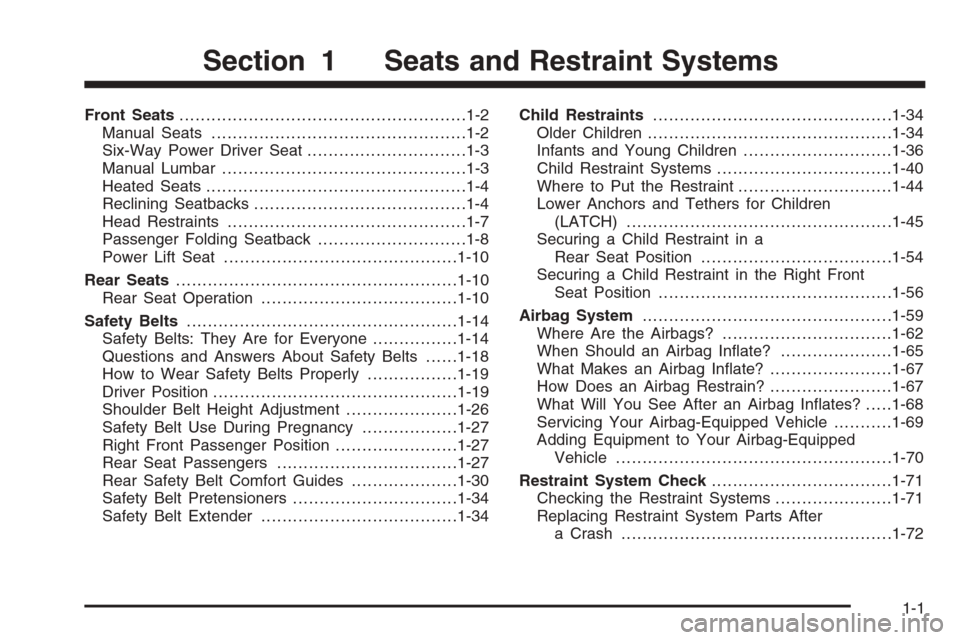
Front Seats......................................................1-2
Manual Seats................................................1-2
Six-Way Power Driver Seat..............................1-3
Manual Lumbar..............................................1-3
Heated Seats.................................................1-4
Reclining Seatbacks........................................1-4
Head Restraints.............................................1-7
Passenger Folding Seatback............................1-8
Power Lift Seat............................................1-10
Rear Seats.....................................................1-10
Rear Seat Operation.....................................1-10
Safety Belts...................................................1-14
Safety Belts: They Are for Everyone................1-14
Questions and Answers About Safety Belts......1-18
How to Wear Safety Belts Properly.................1-19
Driver Position..............................................1-19
Shoulder Belt Height Adjustment.....................1-26
Safety Belt Use During Pregnancy..................1-27
Right Front Passenger Position.......................1-27
Rear Seat Passengers..................................1-27
Rear Safety Belt Comfort Guides....................1-30
Safety Belt Pretensioners...............................1-34
Safety Belt Extender.....................................1-34Child Restraints.............................................1-34
Older Children..............................................1-34
Infants and Young Children............................1-36
Child Restraint Systems.................................1-40
Where to Put the Restraint.............................1-44
Lower Anchors and Tethers for Children
(LATCH)..................................................1-45
Securing a Child Restraint in a
Rear Seat Position....................................1-54
Securing a Child Restraint in the Right Front
Seat Position............................................1-56
Airbag System...............................................1-59
Where Are the Airbags?................................1-62
When Should an Airbag In�ate?.....................1-65
What Makes an Airbag In�ate?.......................1-67
How Does an Airbag Restrain?.......................1-67
What Will You See After an Airbag In�ates?.....1-68
Servicing Your Airbag-Equipped Vehicle...........1-69
Adding Equipment to Your Airbag-Equipped
Vehicle....................................................1-70
Restraint System Check..................................1-71
Checking the Restraint Systems......................1-71
Replacing Restraint System Parts After
a Crash...................................................1-72
Section 1 Seats and Restraint Systems
1-1
Page 14 of 442
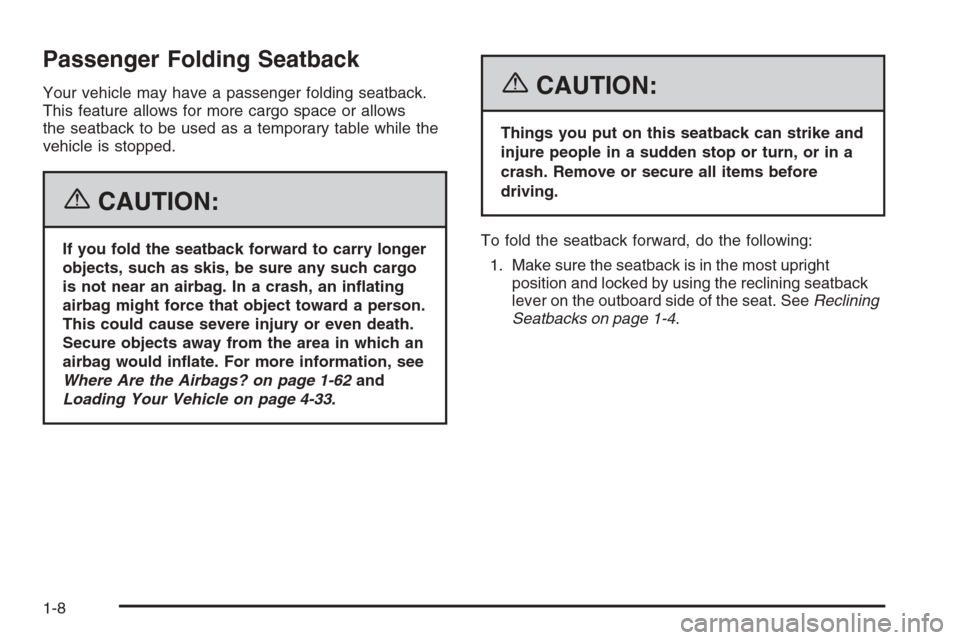
Passenger Folding Seatback
Your vehicle may have a passenger folding seatback.
This feature allows for more cargo space or allows
the seatback to be used as a temporary table while the
vehicle is stopped.
{CAUTION:
If you fold the seatback forward to carry longer
objects, such as skis, be sure any such cargo
is not near an airbag. In a crash, an in�ating
airbag might force that object toward a person.
This could cause severe injury or even death.
Secure objects away from the area in which an
airbag would in�ate. For more information, see
Where Are the Airbags? on page 1-62and
Loading Your Vehicle on page 4-33.
{CAUTION:
Things you put on this seatback can strike and
injure people in a sudden stop or turn, or in a
crash. Remove or secure all items before
driving.
To fold the seatback forward, do the following:
1. Make sure the seatback is in the most upright
position and locked by using the reclining seatback
lever on the outboard side of the seat. SeeReclining
Seatbacks on page 1-4.
1-8
Page 19 of 442
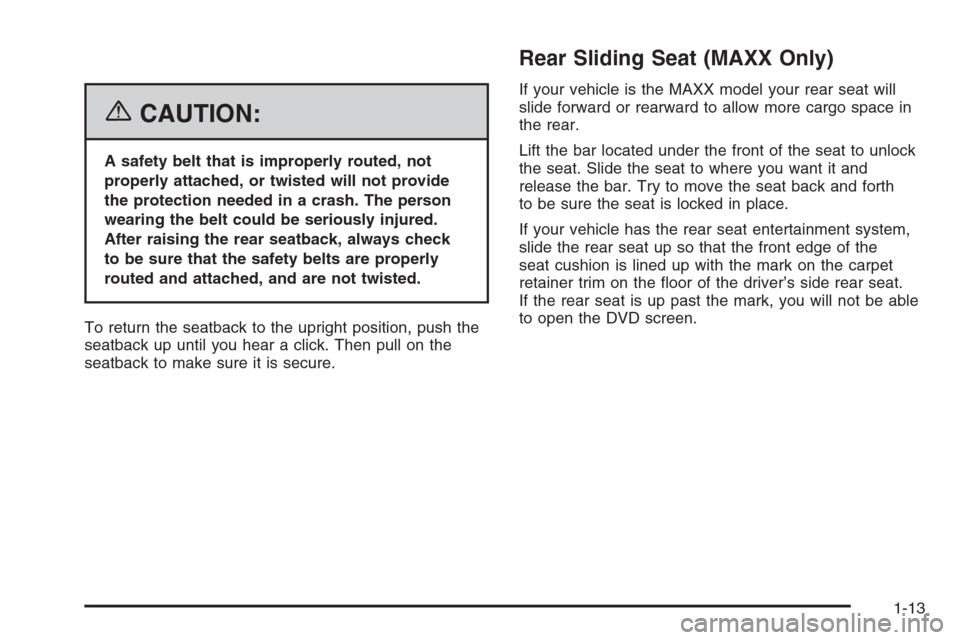
{CAUTION:
A safety belt that is improperly routed, not
properly attached, or twisted will not provide
the protection needed in a crash. The person
wearing the belt could be seriously injured.
After raising the rear seatback, always check
to be sure that the safety belts are properly
routed and attached, and are not twisted.
To return the seatback to the upright position, push the
seatback up until you hear a click. Then pull on the
seatback to make sure it is secure.
Rear Sliding Seat (MAXX Only)
If your vehicle is the MAXX model your rear seat will
slide forward or rearward to allow more cargo space in
the rear.
Lift the bar located under the front of the seat to unlock
the seat. Slide the seat to where you want it and
release the bar. Try to move the seat back and forth
to be sure the seat is locked in place.
If your vehicle has the rear seat entertainment system,
slide the rear seat up so that the front edge of the
seat cushion is lined up with the mark on the carpet
retainer trim on the �oor of the driver’s side rear seat.
If the rear seat is up past the mark, you will not be able
to open the DVD screen.
1-13
Page 26 of 442
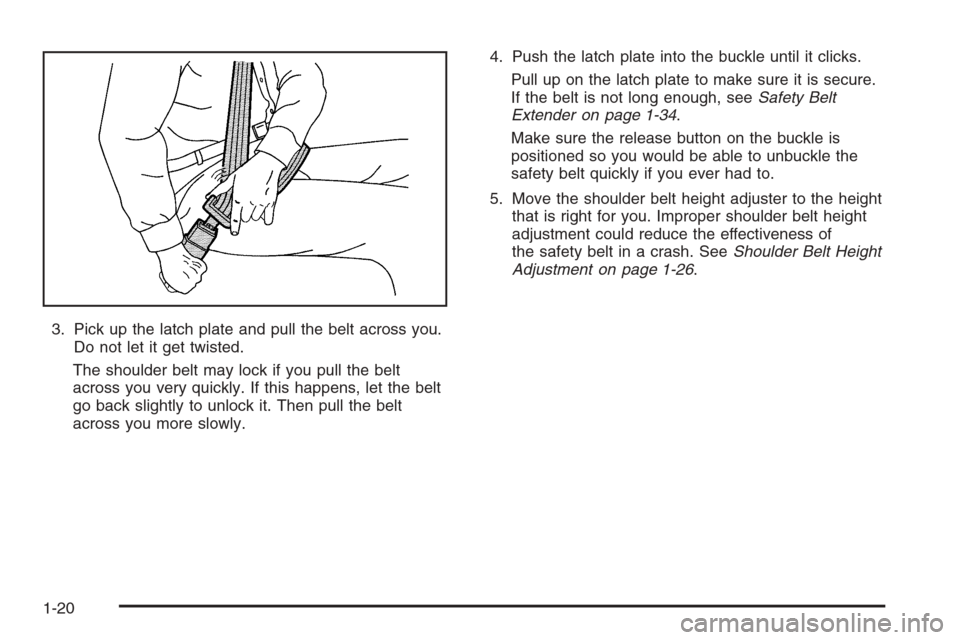
3. Pick up the latch plate and pull the belt across you.
Do not let it get twisted.
The shoulder belt may lock if you pull the belt
across you very quickly. If this happens, let the belt
go back slightly to unlock it. Then pull the belt
across you more slowly.4. Push the latch plate into the buckle until it clicks.
Pull up on the latch plate to make sure it is secure.
If the belt is not long enough, seeSafety Belt
Extender on page 1-34.
Make sure the release button on the buckle is
positioned so you would be able to unbuckle the
safety belt quickly if you ever had to.
5. Move the shoulder belt height adjuster to the height
that is right for you. Improper shoulder belt height
adjustment could reduce the effectiveness of
the safety belt in a crash. SeeShoulder Belt Height
Adjustment on page 1-26.
1-20
Page 34 of 442
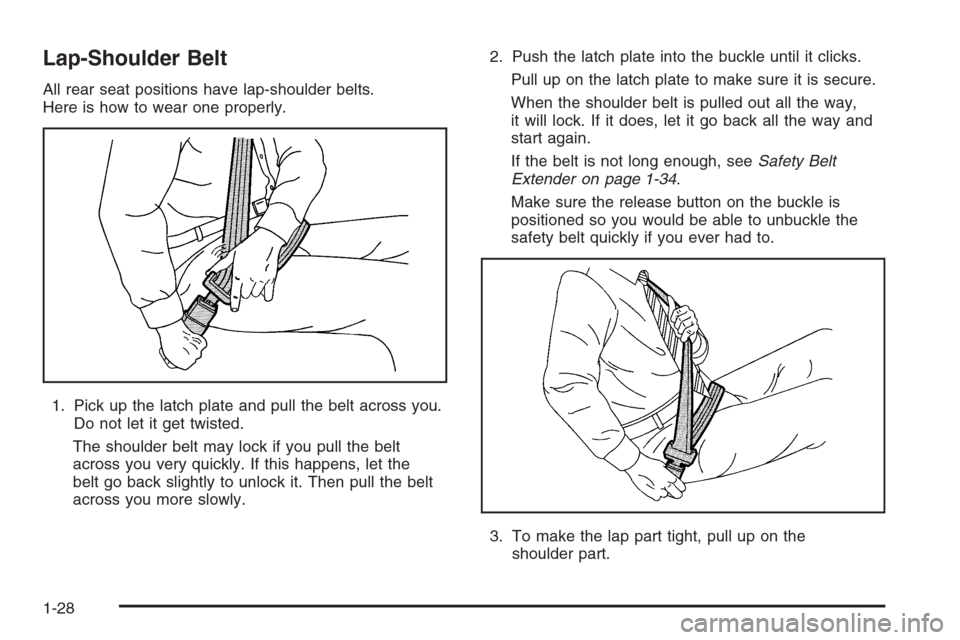
Lap-Shoulder Belt
All rear seat positions have lap-shoulder belts.
Here is how to wear one properly.
1. Pick up the latch plate and pull the belt across you.
Do not let it get twisted.
The shoulder belt may lock if you pull the belt
across you very quickly. If this happens, let the
belt go back slightly to unlock it. Then pull the belt
across you more slowly.2. Push the latch plate into the buckle until it clicks.
Pull up on the latch plate to make sure it is secure.
When the shoulder belt is pulled out all the way,
it will lock. If it does, let it go back all the way and
start again.
If the belt is not long enough, seeSafety Belt
Extender on page 1-34.
Make sure the release button on the buckle is
positioned so you would be able to unbuckle the
safety belt quickly if you ever had to.
3. To make the lap part tight, pull up on the
shoulder part.
1-28
Page 40 of 442
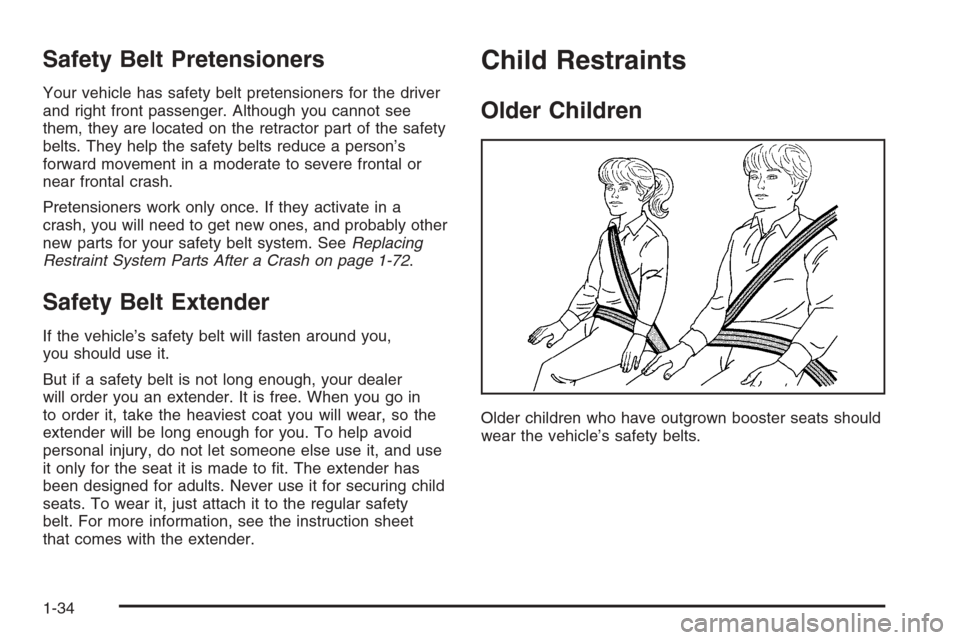
Safety Belt Pretensioners
Your vehicle has safety belt pretensioners for the driver
and right front passenger. Although you cannot see
them, they are located on the retractor part of the safety
belts. They help the safety belts reduce a person’s
forward movement in a moderate to severe frontal or
near frontal crash.
Pretensioners work only once. If they activate in a
crash, you will need to get new ones, and probably other
new parts for your safety belt system. SeeReplacing
Restraint System Parts After a Crash on page 1-72.
Safety Belt Extender
If the vehicle’s safety belt will fasten around you,
you should use it.
But if a safety belt is not long enough, your dealer
will order you an extender. It is free. When you go in
to order it, take the heaviest coat you will wear, so the
extender will be long enough for you. To help avoid
personal injury, do not let someone else use it, and use
it only for the seat it is made to �t. The extender has
been designed for adults. Never use it for securing child
seats. To wear it, just attach it to the regular safety
belt. For more information, see the instruction sheet
that comes with the extender.
Child Restraints
Older Children
Older children who have outgrown booster seats should
wear the vehicle’s safety belts.
1-34
Page 43 of 442
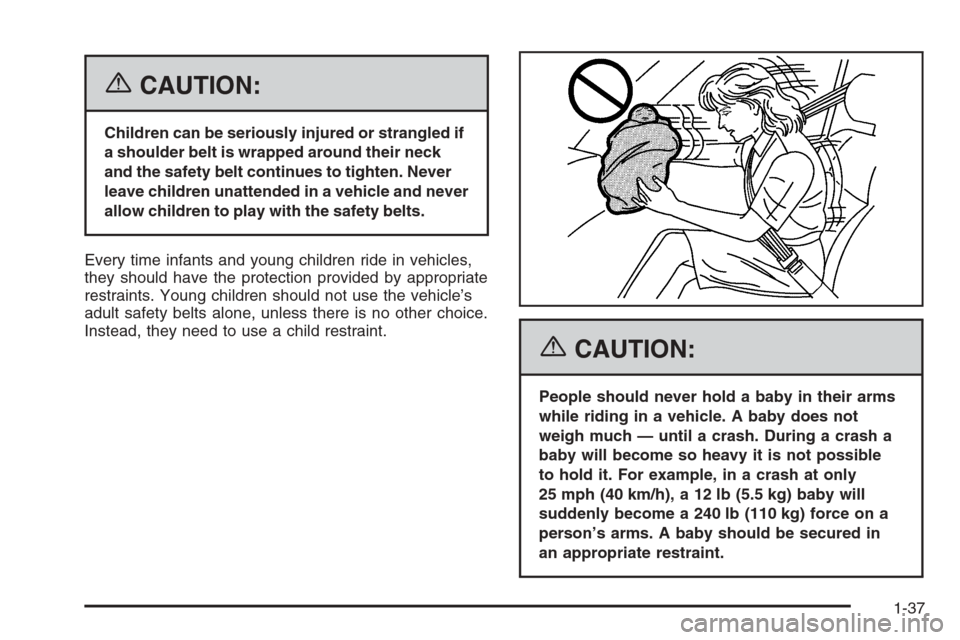
{CAUTION:
Children can be seriously injured or strangled if
a shoulder belt is wrapped around their neck
and the safety belt continues to tighten. Never
leave children unattended in a vehicle and never
allow children to play with the safety belts.
Every time infants and young children ride in vehicles,
they should have the protection provided by appropriate
restraints. Young children should not use the vehicle’s
adult safety belts alone, unless there is no other choice.
Instead, they need to use a child restraint.
{CAUTION:
People should never hold a baby in their arms
while riding in a vehicle. A baby does not
weigh much — until a crash. During a crash a
baby will become so heavy it is not possible
to hold it. For example, in a crash at only
25 mph (40 km/h), a 12 lb (5.5 kg) baby will
suddenly become a 240 lb (110 kg) force on a
person’s arms. A baby should be secured in
an appropriate restraint.
1-37
Page 45 of 442
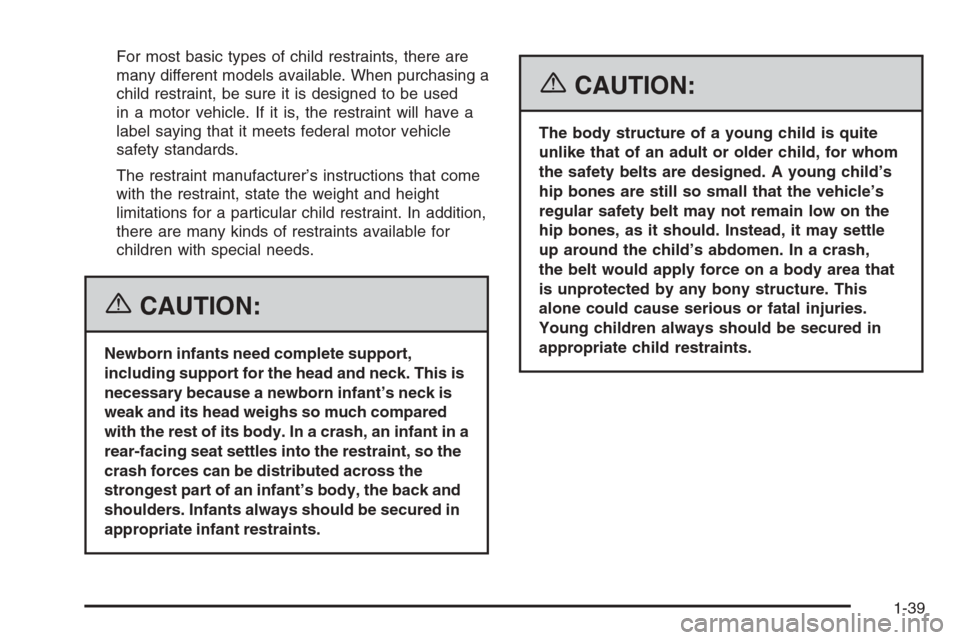
For most basic types of child restraints, there are
many different models available. When purchasing a
child restraint, be sure it is designed to be used
in a motor vehicle. If it is, the restraint will have a
label saying that it meets federal motor vehicle
safety standards.
The restraint manufacturer’s instructions that come
with the restraint, state the weight and height
limitations for a particular child restraint. In addition,
there are many kinds of restraints available for
children with special needs.
{CAUTION:
Newborn infants need complete support,
including support for the head and neck. This is
necessary because a newborn infant’s neck is
weak and its head weighs so much compared
with the rest of its body. In a crash, an infant in a
rear-facing seat settles into the restraint, so the
crash forces can be distributed across the
strongest part of an infant’s body, the back and
shoulders. Infants always should be secured in
appropriate infant restraints.
{CAUTION:
The body structure of a young child is quite
unlike that of an adult or older child, for whom
the safety belts are designed. A young child’s
hip bones are still so small that the vehicle’s
regular safety belt may not remain low on the
hip bones, as it should. Instead, it may settle
up around the child’s abdomen. In a crash,
the belt would apply force on a body area that
is unprotected by any bony structure. This
alone could cause serious or fatal injuries.
Young children always should be secured in
appropriate child restraints.
1-39